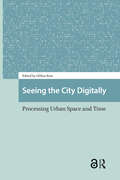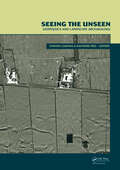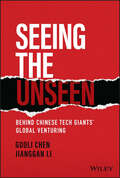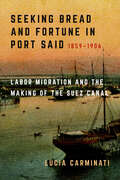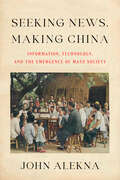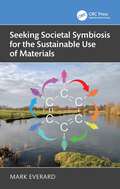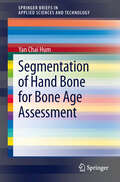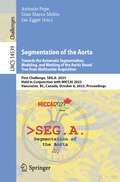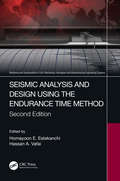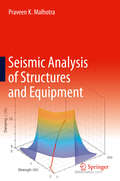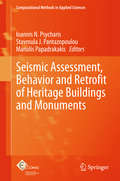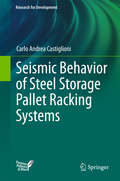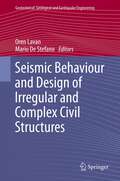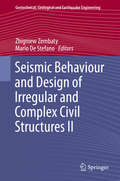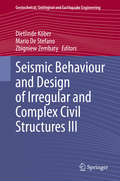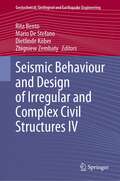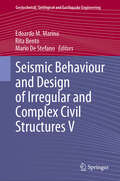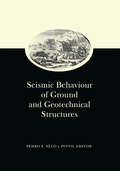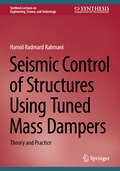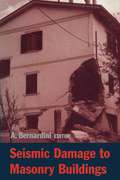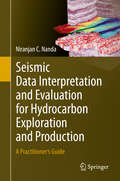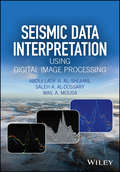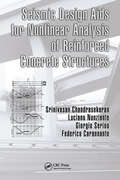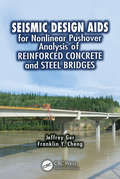- Table View
- List View
Seeing the City Digitally: Processing Urban Space and Time (Cities and Cultures)
by Gillian RoseThis book explores what’s happening to ways of seeing urban spaces in the contemporary moment, when so many of the technologies through which cities are visualised are digital. Cities have always been pictured, in many media and for many different purposes. This edited collection explores how that picturing is changing in an era of digital visual culture. Analogue visual technologies like film cameras were understood as creating some sort of a trace of the real city. Digital visual technologies, in contrast, harvest and process digital data to create images that are constantly refreshed, modified and circulated. Each of the chapters in this volume examines a different example of how this processual visuality is reconfiguring the spatial and temporal organisation of urban life.
Seeing the Unseen. Geophysics and Landscape Archaeology
by Salvatore Piro Stefano CampanaSEEING THE UNSEEN. GEOPHYSICS AND LANDSCAPE ARCHAEOLOGY is a collection of papers presented at the advanced XV International Summer School in ArchaeologyGeophysics for Landscape Archaeology (Grosseto, Italy, 10-18 July 2006). Bringing together the experience of some of the worlds greatest experts in the field of archaeological prospection, the
Seeing the Unseen: Behind Chinese Tech Giants' Global Venturing
by Guoli Chen Jianggan LiMeet the overnight tech success stories of China&’s globalizing business landscape In the last few years, we have seen a meteoric rise of Chinese tech companies across the world. Alibaba stock price movements unnerved investors globally, venture capitalists searched for the next Meituan or Pinduoduo in Southeast Asia and Latin America, and of course, Tik Tok, the most popular content platform in the world today, originated from China. The founders of such companies are typically credited with the &“tenacity to rough it out,&” the &“courage to venture into the unknown,&” and the &“vision to take their companies to new heights.&” However, the same can be said about Silicon Valley founders, or any successful entrepreneur. So, what gives Chinese founders and their companies the advantage in becoming multi-billion global enterprises? How does their leadership set strategies? How do they motivate their people? How do they move so fast and defend their turf in China&’s hyper-competitive tech market? When they expand overseas, how do they determine what they keep and what they need to let go of? And most importantly, what do these things mean to you as a competitor, investor, regulator, or even as an executive or customer of such companies? Seeing the Unseen: Behind Chinese Tech Giants&’ Global Venturing answers these questions and delves into the fascinating world of Chinese logic that shapes how tech leaders make and implement decisions, many of which are seldom seen outside China. In this book, you will gain an accurate, concise understanding of Chinese tech companies' reflections as they scale. You will understand the different generations of Chinese tech giants from Alibaba, Tencent, Baidu and Huawei to Pinduoduo, Meituan, ByteDance, Xiaomi and more. In this Seeing the Unseen, the analysis behind the success and lessons learned is summarized into a unique framework that touches on People, Organization, and Product and Leadership (POP-Leadership). The book covers: How Chinese history, folklore and Mao Zadong&’s political strategies have shaped the strategies of Chinese tech leaders, even today The mindsets of Chinese tech and internet companies and how they have evolved over the last two decades The unique business culture and leadership styles that steered these companies through uncertain and ultra-competitive periods How Chinese companies structure their organizations and products and how they remain agile as they scale The limitations of Chinese POP-Leadership, and what these companies must shed to keep up with international players in global markets How Chinese POP-Leadership is now becoming international, and how international players are leveraging these learnings How the worldwide expansion of Chinese companies will alter the business landscape in the coming decades Chinese firms undertaking overseas ventures can challenge our thinking on global strategy and implementation. This book gives you a better understanding of these emergent players in the global arena.
Seeking Bread and Fortune in Port Said: Labor Migration and the Making of the Suez Canal, 1859–1906
by Lucia CarminatiSeeking Bread and Fortune in Port Said probes migrant labor's role in shaping the history of the Suez Canal and modern Egypt. It maps the everyday life of Port Said's residents between 1859, when the town was founded as the Suez Canal's northern harbor, and 1906, when a railway connected it to the rest of Egypt. Through groundbreaking research, Lucia Carminati provides a ground-level perspective on the key processes touching late nineteenth-century Egypt: heightened domestic mobility and immigration, intensified urbanization, changing urban governance, and growing foreign encroachment. By privileging migrants' prosaic lives, Seeking Bread and Fortune in Port Said shows how unevenness and inequality laid the groundwork for the Suez Canal's making.
Seeking News, Making China: Information, Technology, and the Emergence of Mass Society
by John AleknaContemporary developments in communications technologies have overturned key aspects of the global political system and transformed the media landscape. Yet interlocking technological, informational, and political revolutions have occurred many times in the past. In China, radio first arrived in the winter of 1922-23, bursting into a world where communication was slow, disjointed, or non-existent. Less than ten percent of the population ever read newspapers. Just fifty years later, at the beginning of the Cultural Revolution, news broadcasts reached hundreds of millions of people instantaneously, every day. How did Chinese citizens experience the rapid changes in information practices and political organization that occurred in this period? What was it like to live through a news revolution? John Alekna traces the history of news in twentieth-century China to demonstrate how large structural changes in technology and politics were heard and felt. Scrutinizing the flow of news can reveal much about society and politics—illustrating who has power and why, and uncovering the connections between different regions, peoples, and social classes. Taking an innovative, holistic view of information practices, Alekna weaves together both rural and urban history to tell the story of the rise of mass society through the lens of communication techniques and technology, showing how the news revolution fundamentally reordered the political geography of China.
Seeking Societal Symbiosis for the Sustainable Use of Materials
by Mark Everard‘Crucially, this book bridges a gap in our understanding of how different societal sectors can be united to define roles, identify shared interests and devise strategies that complement progress towards more sustainable material use.This message will be of particular interest to the chemical industry as it seeksnew pathways towards a cyclical economy.’ – Dr Simon Vandestadt, Director, Senior Executive and Researcher, Specialist in peace, conflict and sustainability, Pacific and Papua New GuineaWe live in a material world – one with a rising population dependent upon a base of natural resources that is already seriously depleted and declining rapidly. This book considers the societal use of materials: historically, in the less-than-optimal present and aspirationally as a central thread in addressing wider sustainable development challenges. It accounts for linked chemical, physical and socio-economic consequences right through value chains, from raw material extraction through manufacture and use and onwards to post-use.The author, Mark Everard, proposes that the four principal societal sectors – business, government, civil society organisations and knowledge-providers – though often currently dissipating effort by working antagonistically, can optimally work symbiotically around co-created and consensual long-term sustainability goals to accelerate necessary progress. Practical examples of ‘baby steps’ towards constructive collaboration within and between societal sectors are recognised, and lessons are drawn for how they can shape more committed and intentional collaboration for sustainable development.Seeking Societal Symbiosis touches upon many aspects of science – from chemistry, chemical engineering and material science, through to construction/built environment, sustainability, regulatory science, resources economics and social science. It will be valuable reading for industry managers and executives, the European Commission and MEPs, other national regulators and legislators, university students and lecturers, and NGOs.
Segmentation of Hand Bone for Bone Age Assessment
by Yan Chai HumThe objective of this Brief is to provide a solution to the unsolved technical problem in segmentation for the automated bone age assessment system. The task is accomplished by first applying the modified histogram equalized module, then applying the proposed automated anisotropic diffusion technique. It is followed by a novel fuzzy quadruple division scheme to optimize the central segmentation algorithm, and then an additional quality assurance scheme. The designed segmentation framework works without demanding scarce resources such as training sets and skillful operators. The results have shown that the designed framework is capable of separating the soft-tissue and background from the hand bone with high accuracy. This Brief should be especially useful for students and professional researchers in the Biomedical and image processing fields.
Segmentation of the Aorta. Towards the Automatic Segmentation, Modeling, and Meshing of the Aortic Vessel Tree from Multicenter Acquisition: First Challenge, SEG.A. 2023, Held in Conjunction with MICCAI 2023, Vancouver, BC, Canada, October 8, 2023, Proceedings (Lecture Notes in Computer Science #14539)
by Jan Egger Antonio Pepe Gian Marco MelitoThis book constitutes the First Segmentation of the Aorta Challenge, SEG.A. 2023, which was held in conjunction with the 26th International Conference on Medical Image Computing and Computer-Assisted Intervention, MICCAI 2023, on October 8, 2023. The 8 full and 3 short papers presented have been carefully reviewed and selected for inclusion in the book. They focus specifically on robustness, visual quality and meshing of automatically generated segmentations of aortic vessel trees from CT imaging. The challenge was organized as a ”container submission” challenge, where participants had to upload their algorithms to Grand Challenge in the form of Docker containers. Three tasks were created for SEG.A. 2023.
Seismic Amplitude: An Interpreter's Handbook
by Rob Simm Mike BaconSeismic amplitudes yield key information on lithology and fluid fill, enabling interpretation of reservoir quality and likelihood of hydrocarbon presence. The modern seismic interpreter must be able to deploy a range of sophisticated geophysical techniques, such as seismic inversion, AVO (amplitude variation with offset), and rock physics modelling, as well as integrating information from other geophysical techniques and well data. This accessible, authoritative book provides a complete framework for seismic amplitude interpretation and analysis in a practical manner that allows easy application - independent of any commercial software products. Deriving from the authors' extensive industry expertise and experience of delivering practical courses on the subject, it guides the interpreter through each step, introducing techniques with practical observations and helping to evaluate interpretation confidence. Seismic Amplitude is an invaluable day-to-day tool for graduate students and industry professionals in geology, geophysics, petrophysics, reservoir engineering, and all subsurface disciplines making regular use of seismic data.
Seismic Analysis and Design using the Endurance Time Method (Resilience and Sustainability in Civil, Mechanical, Aerospace and Manufacturing Engineering Systems)
by Homayoon E. EstekanchiThe endurance time method (ETM) is a seismic analysis procedure in which intensifying dynamic excitations are used as the loading function, and it provides many unique benefits in the design of structures. It can largely reduce the computational effort needed for the response history analysis of structures. This aids in the practical application of response history-based analysis in problems involving very large models and/or requiring numerous analyses to achieve optimal design goals. A single response history analysis through ETM provides an estimate of the system response at the entire range of seismic intensities of interest, thus making it ideal for applications such as seismic risk assessment, life-cycle cost analysis, and value-based seismic design. Conceptual simplicity also makes ETM a useful tool for preliminary response history analysis of structural systems. Features: Presents full coverage of the subject from basic concepts to advanced applied topics. Provides a coherent text on endurance time excitation functions that are essential in endurance time analysis. Seismic Analysis and Design using the Endurance Time Method serves as a comprehensive resource for students, researchers, and practicing structural engineers who want to familiarize themselves with the concepts and applications of the endurance time method (ETM) as a useful tool for dynamic structural analysis.
Seismic Analysis of Structures and Equipment
by Praveen K. MalhotraThis book describes methods used to estimate forces and deformations in structures during future earthquakes. It synthesizes the topics related to ground motions with those related to structural response and, therefore, closes the gap between geosciences and engineering. Requiring no prior knowledge, the book elucidates confusing concepts related to ground motions and structural response and enables the reader to select a suitable analysis method and implement a cost‐effective seismic design.Presents lucid, accessible descriptions of key concepts in ground motions and structural response and easy to follow descriptions of methods used in seismic analysis;Explains the roles of strength, deformability, and damping in seismic design;Reinforces concepts with real‐world examples;Stands as a ready reference for performance‐based/risk-based seismic design, providing guidance for achieving a cost-effective seismic design.
Seismic Assessment, Behavior and Retrofit of Heritage Buildings and Monuments
by Manolis Papadrakakis Ioannis N. Psycharis Stavroula J. PantazopoulouThis book assembles, identifies and highlights the most recent developments in Rehabilitation and retrofitting of historical and heritage structures. This is an issue of paramount importance in countries with great built cultural heritage that also suffer from high seismicity, such as the countries of the eastern Mediterranean basin. Heritage structures range from traditional residential constructions to monumental structures, ancient temples, towers, castles, etc. It is generally recognized that these structures present particular difficulties in seismic response calculation through computer simulation due to the complexity of the structural system which is, generally, inhomogeneous, with several contact problems, gaps/joints, nonlinearities and brittleness in material constituents. This book contains selected papers from the ECCOMAS Thematic Conferences on Computational Methods in Structural Dynamics & Earthquake Engineering (COMPDYN) that were held in Corfu, Greece in 2011 and Kos, Greece in 2013. The Conferences brought together the scientific communities of Computational Mechanics, Structural Dynamics and Earthquake Engineering in an effort to facilitate the exchange of ideas in topics of mutual interest and to serve as a platform for establishing links between research groups with complementary activities.
Seismic Behavior of Steel Storage Pallet Racking Systems
by Carlo Andrea CastiglioniThis book presents the mainoutcomes of the first European research project on the seismic behavior ofadjustable steel storage pallet racking systems. In particular, it describes acomprehensive and unique set of full-scale tests designed to assess such behavior. The tests performed include cyclic tests of full-scale rack components, namelybeam-to-upright connections and column base connections; static and dynamictests to assess the friction factor between pallets and rack beams; full-scalepushover and pseudodynamic tests of storage racks in down-aisle and cross-aisledirections; and full-scale dynamic tests on two-bay, three-level rack models. The implications of the findings of this extensive testing regime on theseismic behavior of racking systems are discussed in detail, highlighting e. g. the confirmation that under severe dynamic conditions "sliding" is the mainfactor influencing rack response. This work was conceived during thedevelopment of the SEISRACKS project. Its outcomes will contribute significantlyto increasing our knowledge of the structural behavior of racks underearthquake conditions and should inform future rack design.
Seismic Behaviour and Design of Irregular and Complex Civil Structures
by Mario De Stefano Oren LavanStructural irregularities are one of the most frequent causes of severe damages in buildings, as evidenced by the numerous earthquakes in recent years. This issue is of particular importance, since real structures are almost all irregular. Furthermore, structural irregularities depend on several factors often very difficult to predict. This book is an essential tool for understanding the problem of structural irregularities and provides the most up-to-date review on this topic, covering the aspects of ground rotations, analysis, design, control and monitoring of irregular structures. It includes 24 contributions from authors of 13 countries, giving a complete and international view of the problem.
Seismic Behaviour and Design of Irregular and Complex Civil Structures II
by Mario De Stefano Zbigniew ZembatyIrregular engineering structures are subjected to complicated additional loads which are often beyond conventional design models developed for traditional, simplified plane models. This book covers detailed research and recent progress in seismic engineering dealing with seismic behaviour of irregular and set-back engineering structures. Experimental results as well as special topics of modern design are discussed in detail. In addition, recent progress in seismology, wave propagation and seismic engineering, which provides novel, modern modelling of complex seismic loads, is reported. Particular emphasis is placed on the newly developed rotational, seismic ground-motion effects. This book is a continuation of an earlier monograph which appeared in the same Springer series in 2013 (http://www. springer. com/gp/book/9789400753761).
Seismic Behaviour and Design of Irregular and Complex Civil Structures III (Geotechnical, Geological and Earthquake Engineering #48)
by Mario De Stefano Zbigniew Zembaty Dietlinde KöberThis book presents state-of-the-art knowledge on problems of the effects of structural irregularities on their seismic response. It also covers specific spatial and rotational seismic loads on these structures. Rapid progress in respective research on irregular structures and unconventional seismic loads requires prompt updates of the state of the art in this area. These problems are of particular interest to both researchers and practitioners because these are non-conservative effects compared with the approach of the traditional seismic design (e.g. Eurocode 8, Uniform Building Code etc.). This book will be of particular interest to researchers, PhD students and engineers dealing with design of structures under seismic excitations.
Seismic Behaviour and Design of Irregular and Complex Civil Structures IV (Geotechnical, Geological and Earthquake Engineering #50)
by Mario De Stefano Zbigniew Zembaty Dietlinde Köber Rita BentoThis volume contains papers of the 9th European Workshop on the Seismic Behaviour of Irregular and Complex Structures (9EWICS) held in Lisbon, Portugal, in 2020. This workshop, organized at Instituto Superior Técnico, University of Lisbon, continued the successful three-annual series of workshops started back in 1996. Its organization had the sponsorship of Working Group 8 (Seismic Behaviour of Irregular and Complex Structures) of the European Association of Earthquake Engineering.This international event provided a platform for discussion and exchange of ideas and unveiled new insights on the possibilities and challenges of irregular and complex structures under seismic actions. The topics addressed include criteria for regularity, seismic design of irregular structures, seismic assessment of irregular and complex structures, retrofit of irregular and complex structures, and soil-structure interaction for irregular and complex structures. Beyond an excellent number of interesting papers on these topics, this volume includes the papers of the two invited lectures – one devoted to irregularities in RC buildings, including perspectives in current seismic design codes, difficulties in their application and further research needs, and another one dedicated to the challenging and very up to date topic in the area of seismic response of masonry building aggregates in historical centers. This volume includes 26 contributions from authors of 11 countries, giving a complete and international view of the problem.The holds particular interest for all the community involved in the challenging task of seismic design, assessment and/or retrofit of irregular and complex structures.
Seismic Behaviour and Design of Irregular and Complex Civil Structures V (Geotechnical, Geological and Earthquake Engineering #53)
by Mario De Stefano Rita Bento Edoardo M. MarinoThis volume contains papers of the 10th European Workshop on the Seismic Behaviour of Irregular and Complex Structures (10EWICS) held in Catania, Italy, in 2023. This international event provided a platform for discussion and exchange of ideas and unveiled new insights on the possibilities and challenges of irregular and complex structures under seismic actions. The topics addressed include criteria for regularity and design of buildings with structural irregularity/complexity, assessment and retrofit of buildings with structural irregularity/complexity, irregularity /complexity in high-rise buildings, historical constructions and bridges, soil-structure interaction and special cases of irregularity. Beyond an excellent number of interesting papers on these topics, this volume includes the paper of an invited lecture devoted to rocking seismic resisting systems with focus to concepts, analysis, design, and applicability to irregular buildings. The book is intented for all the community involved in the challenging task of seismic design, assessment and/or retrofit of irregular and complex structures.
Seismic Behaviour of Ground and Geotechnical Structures: Special Volume of TC 4
by Pedro S. Sêco e PintoContaining papers from the Special Technical Session on Earthquake Geotechnical Engineering, this volume includes coverage of: zonation maps; liquefaction; side effects; ground motions; slope instability; seismic behaviour of slopes; dikes and dams; and warning systems.
Seismic Control of Structures Using Tuned Mass Dampers: Theory and Practice (Synthesis Lectures on Engineering, Science, and Technology)
by Hamid Radmard RahmaniThis book begins by describing the Tuned Mass Dampers (TMD) systems to familiarize readers with the basic concepts, followed by a brief review of the state-of-the-art research findings culled from recent studies in the archival literature. In the third chapter, the applicable structural theories are discussed. Next, the authors examine some advanced and applicable optimization techniques, such as the Genetic Algorithm, and related computer algorithms and modeling techniques to help engineers and researchers in performing computer simulations. Examples from the field appear in the last chapter to reinforce the concepts presented. Instilling practical insight into the TMDs, their applications, basic theories, and modeling techniques, the book is ideal for practical engineers, researchers and students of structural engineering.
Seismic Damage to Masonry Buildings: Proceedings of the International Workshop, Padova, Italy, 25-27 June, 1998
by Alberto BernardiniMany traditional masonry buildings are exposed to high intensity earthquakes where the collapse of masonry claims the majority of casualties. This workshop provided a forum for discussion, including survey and measurement, retrofitting criteria and approaches used in different European countries.
Seismic Data Interpretation and Evaluation for Hydrocarbon Exploration and Production
by Niranjan C. NandaThis book introduces readers to the field of seismic data interpretation and evaluation, covering themes such as petroleum exploration and high resolution seismic data. It helps geoscientists and engineers who are practitioners in this area to both understand and to avoid the potential pitfalls of interpreting and evaluating such data, especially the over-reliance on sophisticated software packages and workstations alongside a lack of grasp on the elementary principles of geology and geophysics. Chapters elaborate on the necessary principles, from topics like seismic wave propagation and rock-fluid parameters to seismic modeling and inversions, explaining the need to understand geological implications. The difference between interpretation of data and its evaluation is highlighted and the author encourages imaginative, logical and practical application of knowledge. Readers will appreciate the exquisite illustrations included with the accessibly written text, which simplify the process of learning about interpretation of seismic data. This multidisciplinary, integrated and practical approach to data evaluation will prove to be a valuable tool for students and young professionals, especially those connected with oil companies.
Seismic Data Interpretation using Digital Image Processing
by Abdullatif A. Al-Shuhail Saleh A. Al-Dossary Wail A. MousaBridging the gap between modern image processing practices by the scientific community at large and the world of geology and reflection seismology This book covers the basics of seismic exploration, with a focus on image processing techniques as applied to seismic data. Discussions of theories, concepts, and algorithms are followed by synthetic and real data examples to provide the reader with a practical understanding of the image processing technique and to enable the reader to apply these techniques to seismic data. The book will also help readers interested in devising new algorithms, software and hardware for interpreting seismic data. Key Features: Provides an easy to understand overview of popular seismic processing and interpretation techniques from the point of view of a digital signal processor. Presents image processing concepts that may be readily applied directly to seismic data. Includes ready-to-run MATLAB algorithms for most of the techniques presented. The book includes essential research and teaching material for digital signal and image processing individuals interested in learning seismic data interpretation from the point of view of digital signal processing. It is an ideal resource for students, professors and working professionals who are interested in learning about the application of digital signal processing theory and algorithms to seismic data.
Seismic Design Aids for Nonlinear Analysis of Reinforced Concrete Structures
by Srinivasan Chandrasekaran Luciano Nunziante Giorgio Serino Federico CarannanteTools to Safeguard New Buildings and Assess Existing OnesNonlinear analysis methods such as static pushover are globally considered a reliable tool for seismic and structural assessment. But the accuracy of seismic capacity estimates-which can prevent catastrophic loss of life and astronomical damage repair costs-depends on the use of the correct b
Seismic Design Aids for Nonlinear Pushover Analysis of Reinforced Concrete and Steel Bridges (Advances in Earthquake Engineering)
by Franklin Y. Cheng Jeffrey GerNonlinear static monotonic (pushover) analysis has become a common practice in performance-based bridge seismic design. The popularity of pushover analysis is due to its ability to identify the failure modes and the design limit states of bridge piers and to provide the progressive collapse sequence of damaged bridges when subjected to major earthq
